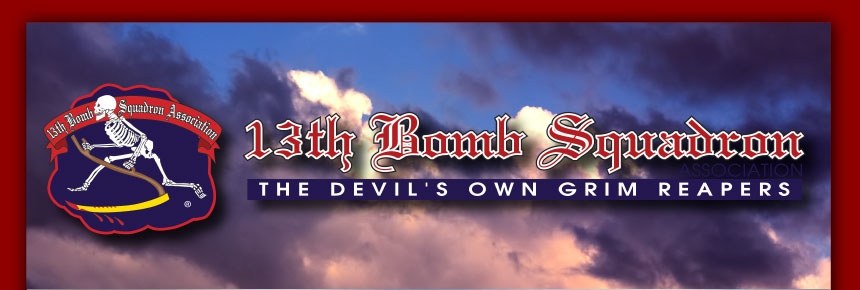| |
 |
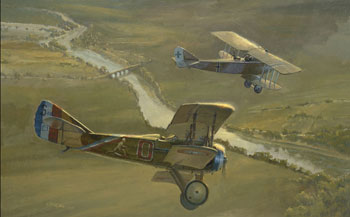 After being organized on 14 June 1917, the 13th Aero Squadron employed the Curtiss JN-4 "Jenny" for training, which included "snake-chasing and cactus-cutting.” The squadron moved to Ohio three weeks after being formed, underwent more training, and then proceeded to New York on 1 November. They sailed from Philadelphia aboard the SS Northland early in December. After being organized on 14 June 1917, the 13th Aero Squadron employed the Curtiss JN-4 "Jenny" for training, which included "snake-chasing and cactus-cutting.” The squadron moved to Ohio three weeks after being formed, underwent more training, and then proceeded to New York on 1 November. They sailed from Philadelphia aboard the SS Northland early in December.
After brief stops at Liverpool, England and Le Havre, France, they reached St. Maixent, France, on 1 January 1918. Here, as well as at Issoudun and Colombey-les-Belles, the pilots tried out their Spad aircraft; joined the 2d Pursuit Group; and moved to Gengoult Field near Toul to commence combat. A detachment of the 13th operated from Meucon in April–May, then at Haussimont in May-June 1918.
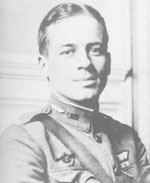 The 13th was charged with protection of the St. Mihiel sector, and its pilots soon were active in intercepting and attacking enemy aircraft that attempted reconnaissance over Allied lines. The Spads also escorted Allied observation planes deep into enemy territory where their pilots sometimes engaged enemy planes and attacked hostile balloons. The 13th was charged with protection of the St. Mihiel sector, and its pilots soon were active in intercepting and attacking enemy aircraft that attempted reconnaissance over Allied lines. The Spads also escorted Allied observation planes deep into enemy territory where their pilots sometimes engaged enemy planes and attacked hostile balloons.
While participating in the St. Mihiel Offensive, which was undertaken to reopen the Paris-Nancy railroad in the vicinity of Commercy, the 13th fought with vigor. While ground forces were attacking and destroying, men, material, and morale, the 13th's pilots kept busy destroying enemy aircraft and balloons, and making the sky safe for Allied observation planes.
The 13th claimed several "aces" from this period of its history: Charles J Biddle, Murray K Guthrie, Frank K Hays, John J Seerly, and William H Stovall.
Major Carl Spaatz, although on orders to return home, sought and received permission to serve with the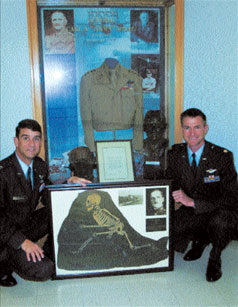 13th Aero Squadron as a pursuit pilot. He subordinated himself to men of lower rank, but as a result of his ardent zeal and ability, he was soon a flight leader and was credited with destroying two Fokkers during the St. Mihiel and Meuse-Argonne campaigns. (NOTE: Major Spaatz went on to become a general officer and commanded the 8th Air Force in Europe during WW II and was the first Chief of Staff of the new United States Air Force in 1947.) 13th Aero Squadron as a pursuit pilot. He subordinated himself to men of lower rank, but as a result of his ardent zeal and ability, he was soon a flight leader and was credited with destroying two Fokkers during the St. Mihiel and Meuse-Argonne campaigns. (NOTE: Major Spaatz went on to become a general officer and commanded the 8th Air Force in Europe during WW II and was the first Chief of Staff of the new United States Air Force in 1947.)
The Meuse-Argonne campaign was launched on 26 September 1918 to reduce the St. Mihiel salient. The 13th Aero Squadron moved on 23 September to Belrain Airdrome near Toul, and from there inflicted heavy losses upon enemy aircraft and balloons. As its pilots gained domination of the air, their responsibilities were expanded to include protection of ground forces, strafing of enemy troops and bombing of targets that could be observed within enemy lines.
On 7 November, the squadron moved to Souilly and continued combat operations until final victory was achieved on 11 November 1918.
On 16 December 1918, the 13th returned to Colombey-les-Belles and disposed of their aircraft. From 6 February to 3 March 1919, the squadron was at the port of embarkation before crossing the Atlantic aboard the SS America. (NOTE: From 13-29 March 1919 the squadron was at Garden City, New York, where it was demobilized. It remained inactive until it was reconstituted in 1936.)
The 104 Aero Squadron (later the 13th Attack Squadron). On 25 August 1917, all unassigned recruits at Kelly Field, Texas, were lined up and 150 men were counted off to form the 104th Aero Squadron. After a period of preparation and rudimentary training, the 104th moved to Garden City, New York, from 4-22 November 1917. On 28 November, the squadron sailed aboard the SS Baltic and arrived at Liverpool, England, on 8 December. There, the squadron was split into four flights, with each flight going to a separate English flying school for training.
The headquarters flight was established at Winchester, before moving to Upavon and then to Netheravon. Other flights went to Salisbury, Andover and Yatesbury.
On 10 July 1918, all four flights met at Winchester to prepare for movement to The Front, but an outbreak of Spanish influenza delayed their movement from crossing The Channel to Le Harve for nine days. Finally reaching Luxeuil-les-Bains on 8 August, the squadron became part of the V Corps Observation Group. Equipped with Salmson aircraft, the 104th directed its efforts toward infantry liaison and observation.
By 8 September, the squadron was ready for action, and it moved to Souilly, where it participated in the St. Mihiel offensive, serving primarily as the eyes of the artillery. Pilots flew reconnaissance, directed Allied artillery fire and pinpointed troop movements. The demand for artillery fire adjustments through aerial observation was constant in spite of difficulties encountered in air-to-ground communications. It was largely due to the photos made by aerial reconnaissance that the Allied infantry knew where it was advancing. As the war progressed, the observations and reconnaissance of the 104th were more in demand.
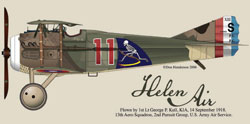 During the Meuse-Argonne offensive, the 104th operated from Foucaucourt (near Verdun) where it had moved on 20 September. The squadron continued its previous operations and also performed other tasks such as engaging the enemy in aerial combat and attacking enemy machine-gun nests. It also dropped thousands of propaganda leaflets over German lines and thousands of newspapers to American soldiers. During the Meuse-Argonne offensive, the 104th operated from Foucaucourt (near Verdun) where it had moved on 20 September. The squadron continued its previous operations and also performed other tasks such as engaging the enemy in aerial combat and attacking enemy machine-gun nests. It also dropped thousands of propaganda leaflets over German lines and thousands of newspapers to American soldiers.
In the final days of the war the I04th operated from Parois, with a flight deployed at Barricourt. The war ended on 11 Nov 1918, and by the end of that month the 104th was together again at Belrain where it remained until mid-January 1919---at which time it began a series of moves which led it to Bordeaux, France, in April. On 18 April, the squadron boarded the SS Orizabe, and nine days later disembarked in New York.
The wholesale discharge of personnel soon depleted the l04th strength. In May, now located at Mitchel Field, New York, the squadron was down to one officer and one enlisted man which made it a ”paper unit.”
About 15 May, the 104th moved to Fort Bliss, Texas, and during June to Kelly Field, Tex, still manned in name only. On 1 July 1919 the squadron was re-designated as the l04th Squadron and was assigned to the Army Surveillance Group (which later was designated 1st Surveillance Group and still later became 3d Attack Group).
During August 1919, nearly 200 men from Mitchel FieId, New York, moved to Kelly Field, Texas, to bring the squadron up to strength. The 104th quickly adapted to peacetime soldiering in the nation's infant air organization.
Three months later, in Nov 1919, the squadron split into three flights: Headquarters Flight and Flight A went to Fort Bliss, Texas, while Flight B deployed to Marfa, Texas. Each flight used DH-4s to perform patrols along the US-Mexican border. From 10 September to 4 November, Flight B was located at Post Field, Oklahoma, but it returned to Marfa on 17 November 1920, and remained there until June 1921.
On 14 March 1921, the 104th Squadron was re-designated the 13th Squadron. In May all of the flights were ordered to participate in maneuvers at Langley Field, Virginia. Then on 2 July, the entire squadron moved to Kelly Field, Texas, and remained there until the squadron was inactivated in June 1924. Earlier on 25 January 1923, the squadron was re-designated the 13th Attack Squadron and acquired a change of duties.
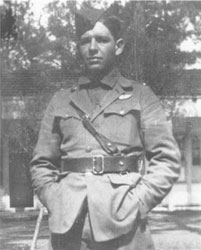 Under its parent (3d Attack Group) the 13th conducted a series of suitability tests of new types of aircraft. Initially tested was the XB-lA, an observation plane to be used for photography, bombardment and liaison work. Under its parent (3d Attack Group) the 13th conducted a series of suitability tests of new types of aircraft. Initially tested was the XB-lA, an observation plane to be used for photography, bombardment and liaison work.
The next aircraft was the GAX (GA-l), a ground attack triplane. These tests were conducted to determine the capability of aircraft under hard service incurred during long cross-country flights. All squadron officers and enlisted personnel attended classes to learn everything they could about the aircraft.
In 1923, the 13th Attack Squadron returned to the DH-4 aircraft and performed aerial demonstrations, formation flying, and normal training. The squadron was inactivated on 27 June, 1924 and remained inactive for over five years.
Brought out of retirement on 1 November 1929, the 13th Attack Squadron again joined the 3d Attack Group at Langley Field, Virginia. Two weeks later the squadron moved to Fort Crockett, Texas. From 1929 to 1934, the squadron flew the A-3 aircraft, and then converted to newer A-12s. In February 1935, the 13th moved to Barksdale Field, Louisiana, where in 1936 it converted to the A-17 aircraft in the Consolidated Squadron. On 16 October 1936, the War Department reconstituted the 13th Aero Squadron and consolidated it with the existing 13th Attack Squadron, forming a single squadron with two separate origins, thus perpetuating the history and traditions of both.
The 13th Attack Squadron designation was retained for the consolidated unit, which continued flying A-17s through 1939 as part of the 3d Attack Group. On I5 September 1939 the squadron became the 13th Bombardment Squadron (Light), while its parent became the 3rd Bombardment Group (Light). B-18 bombers were gained about this same time, but some B-12s were also flown in the 1939-1941 period as the 13th developed into a proficient bombardment squadron. The 3d Group moved to Savannah, Georgia in October 1940, and in 1941 they received A-20s to replace their B18s and B-12s.
|
|
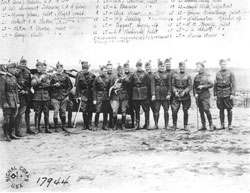 |
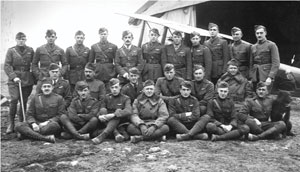 |
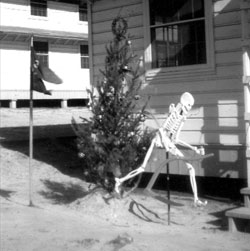 |
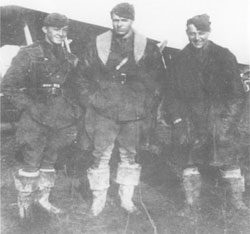 |
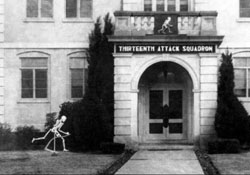 |
Article taken from Invader Magazine July 2002
How It Was 1918 |
Article taken from Invader Magazine July 2008
Riders in the Sky |
Article taken from Invader Magazine March 2006
Biddle's Rumpler Two Seater |
| back to top |
|
 |
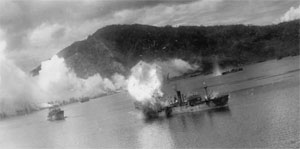 War came to our Nation on 7 December 1941, and within a week the 13th Squadron departed for Daniel Field, Georgia, where it underwent intensive training in bombing and gunnery. Upon returning to Savannah, Georgia, the squadron continued combat training, plus flew antisubmarine patrols along the Atlantic Coast. Orders soon directed the 3d Group and its squadrons to move to the Pacific Theater for combat. War came to our Nation on 7 December 1941, and within a week the 13th Squadron departed for Daniel Field, Georgia, where it underwent intensive training in bombing and gunnery. Upon returning to Savannah, Georgia, the squadron continued combat training, plus flew antisubmarine patrols along the Atlantic Coast. Orders soon directed the 3d Group and its squadrons to move to the Pacific Theater for combat.
The 13th left its A-20s at Savannah on 19 January 1942, when it moved to San Francisco, California, then sailed from the Port of San Francisco for Australia aboard the USS Ancon. Brisbane, Australia, was reached on 25 February, and Charters Towers, Australia, on 10 March 1942.
After appropriating B-25 aircraft that had been intended for the Dutch Government, the 13th entered into an intensive familiarization period with the new type of aircraft, and on 6 April were prepared for combat.
Following the attack on Pearl Harbor and the Philippines, the Japanese had pushed southward and eastward in the Pacific. Only the courageous defense of garrisons in Bataan, Corregidor and Singapore won precious time enabling the Allies to prepare for a counter offensive.
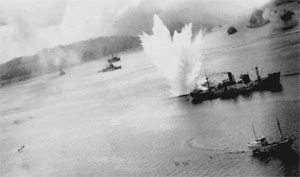 On Corregidor, Lt. General Jonathan Wainwright was still defending the last American base in the Philippines, when the Grim Reapers (the nickname of the 13th Squadron) participated in one of the outstanding operations of the war which earned for the squadron its first two Distinguished Unit Citations. On Corregidor, Lt. General Jonathan Wainwright was still defending the last American base in the Philippines, when the Grim Reapers (the nickname of the 13th Squadron) participated in one of the outstanding operations of the war which earned for the squadron its first two Distinguished Unit Citations.
Taking off from Charters Towers, on 11 April 1942, and refueling at Darwin, Australia, eight B-25s of the 13th (a majority of its resources), accompanied by two B-25s and three B-17s from other units, flew to secret bases in the Philippines. From these bases, the 13th carried the attack directly to the enemy. On 12 April, the small task force made two strikes against Cebu City and were intercepted by four Japanese aircraft--two of which they shot down. They also sank a 7,000-ton enemy transport, and started numerous fires in the warehouses and dock areas. Later that day, the squadron damaged a 16,000-ton transport, and set fire to pier and supply areas at Bohol Island.
The following day the aircraft twice attacked Davao, Mindinao, and once more struck Cebu. In the Davao raids, they sank a transport, bombed an airfield, strafed grounded aircraft, attacked Japanese troops, destroyed a seaplane, and caused extensive damage to docks and warehouses. At Cebu they sank a medium-sized transport vessel.
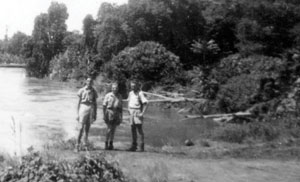 Upon returning to Australia on 14 April, the planes then returned to the Philippines to evacuate a number of military personnel who had held out against the Japanese for four months. These operations by the 3d Bombardment Group, plus the Doolittle Raid on Tokyo, Japan, a few days later, injected a tremendous boost in morale to men on all fighting fronts and to the people of the United States at a time when the nation was suffering from the worst series of military reverses in its history. Upon returning to Australia on 14 April, the planes then returned to the Philippines to evacuate a number of military personnel who had held out against the Japanese for four months. These operations by the 3d Bombardment Group, plus the Doolittle Raid on Tokyo, Japan, a few days later, injected a tremendous boost in morale to men on all fighting fronts and to the people of the United States at a time when the nation was suffering from the worst series of military reverses in its history.
After the brief strikes of April 1942, the 13th went on during the remainder of 1942 to engage the enemy in the Papuan Campaign. About 10 January 1943, the 13th moved from Charters Towers, Australia, to Port Moresby, New Guinea, to be nearer to the enemy it was fighting. As Allied ground forces in Papua stopped the Japanese drive toward Port Moresby, the pilots of the 13th bombed and strafed the enemy from the air, hitting supplies, airfields, shipping and troop concentrations wherever found. By 31 January, the enemy was driven back to the northeast coast of New Guinea, although they were not completely driven off the island until 1944.
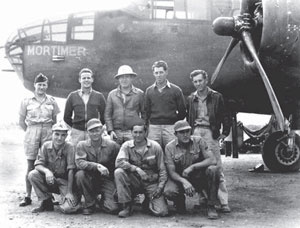 Attacks against enemy ships transporting reinforcements and supplies resulting in the 13th sinking a large (6,000-8,000-ton) cargo ship and a destroyer during March 1943. But, on 12 April 1943, the 13th was on the receiving end when over one-hundred Japanese planes attacked Allied airfields in the area of Port Moresby, New Guinea. The squadron had seven B-25s at this time, and all of them were damaged or destroyed, which temporarily put the squadron out of action. Attacks against enemy ships transporting reinforcements and supplies resulting in the 13th sinking a large (6,000-8,000-ton) cargo ship and a destroyer during March 1943. But, on 12 April 1943, the 13th was on the receiving end when over one-hundred Japanese planes attacked Allied airfields in the area of Port Moresby, New Guinea. The squadron had seven B-25s at this time, and all of them were damaged or destroyed, which temporarily put the squadron out of action.
During May, the 13th moved to Dobodura, New Guinea, and in July was reequipped with B-25 "strafers.” (These were B-25s with six 50 cal guns in the nose to go with four 50 cal guns in the wings). The Grim Reapers once more struck out against Japanese shipping, airfields, and supply dumps in New Guinea and the Bismarck Archipelago---the group of islands off the northeastern coast of New Guinea.
B-25s were used through January 1944, but in February when the 13th moved to Nadzab, New Guinea, A-20s were received and the new planes were soon being used for low-level attacks against Tadji Airdrome near Aitape and Kavien on New Ireland Island in Papua. The 13th led the first low-level attack against Hollandia (on the northern coast of New Guinea on Humboldt Bay) in support of the assault landing there on 22 April 1944, and in May the squadron moved forward to Hollandia. From its new base, the 13th continued to pound the enemy.
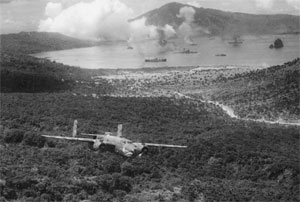 In October 1944, as the New Guinea Campaign slowed down and the Leyte campaign in the northern Philippines became important, the squadron moved to Dulag, on the island of Leyte. The squadron's aircraft and crews, however, continued to operate from Hollandia, New Guinea, since heavy rains made it impossible to maintain the airstrips on Leyte. In October 1944, as the New Guinea Campaign slowed down and the Leyte campaign in the northern Philippines became important, the squadron moved to Dulag, on the island of Leyte. The squadron's aircraft and crews, however, continued to operate from Hollandia, New Guinea, since heavy rains made it impossible to maintain the airstrips on Leyte.
Two weeks after the island of Mindoro, in Luzon, Philippines, was invaded, the 13th moved aircraft and crews from Hollandia to San Jose, Philippines.
On 19 January 1945, the 13th commenced operations against the enemy in Luzon, reinforcing an invasion which was already underway. As the campaign to rid the Philippines of the enemy continued, the 13th's A-20s struck repeatedly at Japanese shipping and garrisons on Luzon, Cebu, Negros, and other islands where Allied ground forces were advancing.
By July 1945, combat activity in the Philippines had dwindled. The 13th converted to A-26 aircraft and prepared to move to Okinawa, Japan, another step nearer the enemy's homeland. On about 7 August, the squadron's ground echelon arrived on Okinawa, and soon thereafter the air echelon arrived from Mindoro. On 9 August, the 13th participated in the all out aerial offensive flying missions against Japanese targets, just before the enemy capitulation brought World War II to a close when the Japanese signed the surrender on the Battleship USS Missouri 2 September 1945.
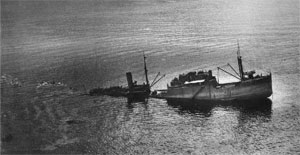 The squadron reverted to peacetime status, flying daily reconnaissance missions over southern Japan to determine the status of airfields and lines of communication. The 3rd Group was selected to become part of the Army of Occupation of Japan, and on about 10 October, the 13th Bombardment Squadron moved to Atsugi Airdrome, Japan, where it became part of the occupational forces. The squadron reverted to peacetime status, flying daily reconnaissance missions over southern Japan to determine the status of airfields and lines of communication. The 3rd Group was selected to become part of the Army of Occupation of Japan, and on about 10 October, the 13th Bombardment Squadron moved to Atsugi Airdrome, Japan, where it became part of the occupational forces.
The final months of 1945 saw the last of the 13th squadron’s A-20s transferred. Replaced by younger crews, most of the squadron’s war veterans returned home.
For the next five years, the 13th Squadron enjoyed a casual routine existence training with its A-26s, (later called B-26s) and participating in occasional exercises.
|
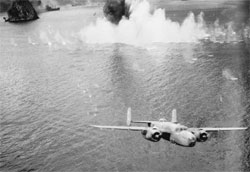 |
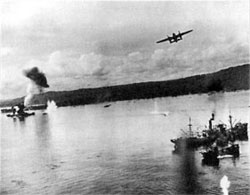 |
Article taken from Invader Magazine March 2003
WW II - Grim Reaper Diplomacy |
Article taken from Invader Magazine March 2010
Wewak Raid |
Article taken from Invader Magazine March 2005
Air Power Strategist by Carl A. Spaatz |
| back to top |
|
 |
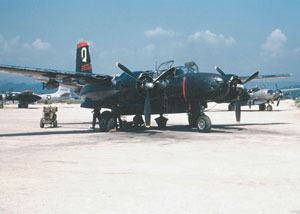 In June 1950, when North Korea precipitated war by invading South Korea, the 13th Bombardment Squadron was undermanned and not properly trained. Its aircraft were old B-26s, most of which had seen action in World War II. Major Walter S. King, who assumed command of the 13th in October 1950, reported, "No one expected the unit to go to war; no action was taken to prepare for war.” In June 1950, when North Korea precipitated war by invading South Korea, the 13th Bombardment Squadron was undermanned and not properly trained. Its aircraft were old B-26s, most of which had seen action in World War II. Major Walter S. King, who assumed command of the 13th in October 1950, reported, "No one expected the unit to go to war; no action was taken to prepare for war.”
In short, like many other units in the Far East and elsewhere, the 13th was unprepared for combat. When the Korean War began on 25 June 1950, the squadron had been deployed to Matsushima Airdrome, Japan, participating in a routine exercise. The squadron was rushed back to its home base and the aircraft and crews then deployed to Ashiya Air Base to launch attacks.
It was 28 June 1950, when the 13th flew its first combat mission of the new war. That morning, twelve of its B-26s bombed railway yards at Munsan and then turned their guns and rockets on motor vehicles and other targets in the area. The attack was made at low level and several planes were damaged by ground fire. One B-26 lost an engine and landed at Suwon, Korea. Another made it back to Ashiya, 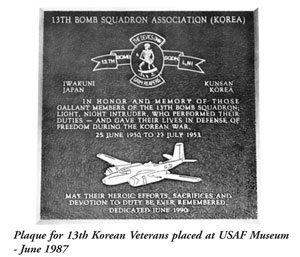 Japan, but was so damaged that it had to be junked. A third aircraft crashed as it attempted to land at Ashiya. Japan, but was so damaged that it had to be junked. A third aircraft crashed as it attempted to land at Ashiya.
On 2 July, the entire squadron moved to Iwakuni, Japan. During the next four weeks, the squadron flew 381 sorties, most of them directed against enemy lines of supply and communications. The crews fired 127,370 rounds of 50 caliber ammunition; dropped 463 500-lb general purpose bombs; 297 500-lb fire bombs; 254 260-lb fragmentation bombs; 970 parafrag bombs; and fired 348 five-inch rockets. Eight planes and four men were lost during the month of combat. By the end of July, however; the crews were more experienced as their results were to indicate.
Now fully engaged in a new war, the men of the 13th found as much difference between the Korean War and World War II as there had been between the two World Wars. According to accepted techniques, the squadron initially conducted its interdictory missions during daylight hours. However, its efforts to curtail and disrupt Communist logistics were seriously limited because the enemy used the cover of night to move troops and supplies. The solution was to shift to night operations. After mid-September, the 13th flew most of its combat missions at night. During October 1950, for example, only 15 of the squadron’s 238 missions were flown during daylight. When the 13th commenced its "Hoot Owl” night operations, it dispatched B-26s singly to reconnoiter specific routes and to harass whatever enemy traffic was observed.
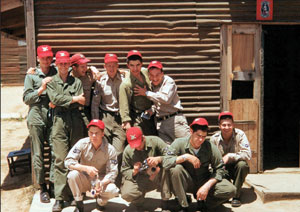 B-29s (and later C-47s) assisted by dropping flares to illuminate targets for the B-26s, and in February 1951, the B-26s began carrying and dropping their own flares. B-26s also began operating in pairs, with each crew taking a turn at dropping flares while the second crew attacked the target. On 25 June 1951 the squadron was re-designated the 13th Bombardment Squadron, (Light, Night Intruder), a name more in keeping with their new mission. B-29s (and later C-47s) assisted by dropping flares to illuminate targets for the B-26s, and in February 1951, the B-26s began carrying and dropping their own flares. B-26s also began operating in pairs, with each crew taking a turn at dropping flares while the second crew attacked the target. On 25 June 1951 the squadron was re-designated the 13th Bombardment Squadron, (Light, Night Intruder), a name more in keeping with their new mission.
The night intruder operations proved to be costly when the number of aircraft lost and the ammunition expended were weighed against the damage inflicted upon the enemy.
The 13th Squadron made a major contribution in search for more effective tactics. While Lt Colonel Estes B. Sherrill was commander of the squadron in the summer and fall of 1952, he analyzed intruder operations and devised a new tactic. A "Hunter" plane was dispatched to establish a road block by dropping general purpose and butterfly (fragmentation) bombs at the front and back of the convoy. Another B-26 then illuminated the target area, and a third B-26 attacked vehicles backed up on the road as a result of the blockade. These tactics resulted in a substantial increase in numbers of vehicles destroyed per B-26 sortie.
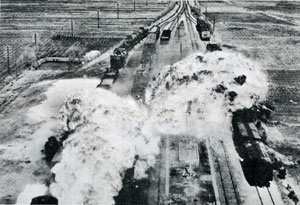 Until mid-August 1951, the 13th had continued to operate from Japan, but had staged many missions from Taegu, South Korea. In August 1951, the squadron moved to Kunsan Airfield, South Korea, making their combat sorties much closer to the targets. The 13th remained there throughout the rest of the war, which was halted with the Armistice in July 1953. However, training activities in the post-Korean War period were much more intense than in the late 1940s, and crews remained proficient in bombing tactics through frequent exercises. In addition to routine practice missions in gunnery and bombing, the squadron participated in many deployments that saw its planes and crews operate from bases in Japan, Korea, and even the Philippines. The squadron moved back to Johnson Air Base (AB), Japan, on 2 October 1954. Until mid-August 1951, the 13th had continued to operate from Japan, but had staged many missions from Taegu, South Korea. In August 1951, the squadron moved to Kunsan Airfield, South Korea, making their combat sorties much closer to the targets. The 13th remained there throughout the rest of the war, which was halted with the Armistice in July 1953. However, training activities in the post-Korean War period were much more intense than in the late 1940s, and crews remained proficient in bombing tactics through frequent exercises. In addition to routine practice missions in gunnery and bombing, the squadron participated in many deployments that saw its planes and crews operate from bases in Japan, Korea, and even the Philippines. The squadron moved back to Johnson Air Base (AB), Japan, on 2 October 1954.
In July 1955, the unit started its conversion from the older B-26s to modern B-57s when the 3rd Bombardment Group began sending crews to the United States for transition training.
|
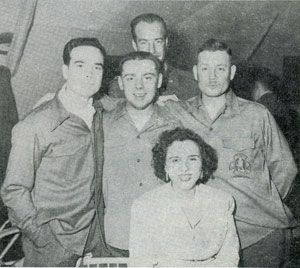 |
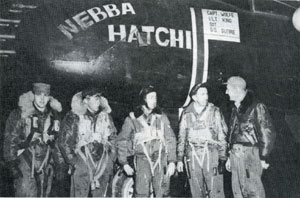 |
Article taken from Invader Magazine November 2004
The Korean War - Those Amazing B-26's |
Article taken from Invader Magazine Fall 1989
Another View of the Early Days |
Article taken from Invader Magazine July 1991
This Bomb is Ticking |
| back to top |
|
 |
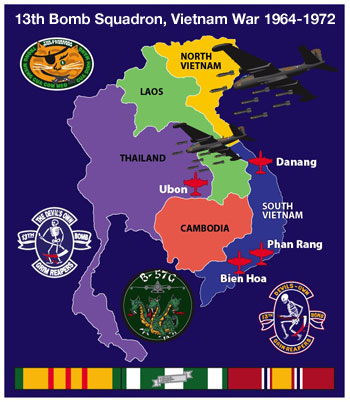 When crews began ferrying B-57s across the Pacific to the 3rd Bomb Wing, the first new aircraft started arriving in January 1956 at Johnson AB, Japan, and were assigned to the 8th Bomb Squadron. When crews began ferrying B-57s across the Pacific to the 3rd Bomb Wing, the first new aircraft started arriving in January 1956 at Johnson AB, Japan, and were assigned to the 8th Bomb Squadron.
The 13th received its B-57s in March l956, and by May had 17 of the new planes. From late May to August, the B-57s were grounded for modifications, but once released for flying, they were used extensively by the 13th to attain the proficiency required of a bombardment squadron.
With the new planes, on 1 October 1955 the unit’s designation changed to 13th Bombardment Squadron, Tactical. From then until November 1960, the 13th carried out its operational commitments from Johnson AB, before heading to Yokota AB, Japan, under the 3rd Bomb Wing in December 1960. On 1 September 1963, when the 3rd Wing became non-operational, the 13th was attached for operational control to the 41st Air Division. Four months later, the 3rd Wing moved to the U.S. without personnel or equipment, and the squadron was reassigned to the 41st Air Division.
Since nuclear weapons could not be stationed in Japan, in August 1958, the 3rd Bomb Group set up a rotation of crews for alert duty at Kunsan AB, Korea. This rotation continued until 2 April 1964. The remainder of the squadron participated in exercises in Japan, Okinawa, and elsewhere in the Pacific.
Communist infiltration and attacks by North Vietnam into South Vietnam rose in 1963 and threatened the government of South Vietnam. As a result US Air Forces were moved to Southeast Asia in support of South Vietnam through the Southeast Asia Treaty Organization. On 10 April 1964, the 13th moved to Clark AB, in the Philippines, where it became part of Thirteenth Air Force. Along with its sister squadron, the 8th Bomb Squadron, Tactical, the 13th was part of the mobile strike force of the 405th Fighter Wing of the 13th Air Force. The two squadrons were attached to the 405th for operational control until November 1964, at which time they were assigned as components of the wing.
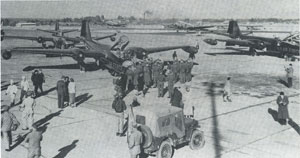 After moving to the Philippines, the 13th performed training and exercises aimed at keeping it proficient in bombardment and gunnery. From 19 to 31 May 1964, the 13th played host to the Royal Australian Air Force No. 2 Squadron, whose Canberra bombers were deployed at Clark AB from Malaya In May the 13th also furnished a few aircraft and crews to support combat operations in Southeast Asia at Tan Son Nhut Air Base near Saigon. By 30 June, the 13th crews had flown 118 combat support missions in South Vietnam. After moving to the Philippines, the 13th performed training and exercises aimed at keeping it proficient in bombardment and gunnery. From 19 to 31 May 1964, the 13th played host to the Royal Australian Air Force No. 2 Squadron, whose Canberra bombers were deployed at Clark AB from Malaya In May the 13th also furnished a few aircraft and crews to support combat operations in Southeast Asia at Tan Son Nhut Air Base near Saigon. By 30 June, the 13th crews had flown 118 combat support missions in South Vietnam.
Following the Gulf of Tonkin incident of 2 August 1964, the 13th and the 8th Squadrons alternated crew deployments to Southeast Asia to maintain alert for combat strikes--although for several months only reconnaissance missions were flown.
On 5 August 1964, both squadrons deployed as ADVON 1, 405th Fighter Wing, with the 13th Commander in charge. Two weeks later, half of the crews returned to Clark AB and an 8th and 13th rotation program began in which half of each squadron operated at Clark under the 405th Fighter Wing and half operated at Bien Hoa AB, South Vietnam, under the operational control of 2nd Air Division.
On 1 November 1964, an enemy mortar attack against Bien Hoa AB destroyed five B-57s of the 8th and 13th Squadrons and damaged several more. Two days later, the crews of the two deployed squadrons were reduced to four crews and four aircraft per squadron. By late December, this was raised to eight crews and eight aircraft per squadron.
The 8th and 13th Squadrons continued maintaining a limited number of their aircraft and crews at Bien 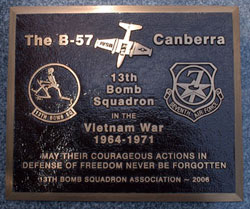 Hoa until 17 February 1965, on which date the Commander of the13th, Major Howard O'Neal, led a flight of four B-57s from Clark to Bien Hoa to augment the deployed forces. Until 19 February 1965, the B- 57s in Southeast Asia continued to be used in a reconnaissance role while constantly preparing for strike missions. However, this changed on 19 February 1965 when the first strike missions were flown against a suspected Viet Cong guerilla concentration about 50 miles from Bien Hoa. Hoa until 17 February 1965, on which date the Commander of the13th, Major Howard O'Neal, led a flight of four B-57s from Clark to Bien Hoa to augment the deployed forces. Until 19 February 1965, the B- 57s in Southeast Asia continued to be used in a reconnaissance role while constantly preparing for strike missions. However, this changed on 19 February 1965 when the first strike missions were flown against a suspected Viet Cong guerilla concentration about 50 miles from Bien Hoa.
More B-57s and crews moved to Bien Hoa on 20 February and still more on 23 February, leaving only a few of the 13th's planes and crews at Clark AB, Philippines. Combat missions became frequent and on 13 April 1965, the first of many night missions over North Vietnam was flown in addition to the usual daytime strikes.
From 19 February through 15 May 1965, the 13th Squadron dropped about 2,500 tons of bombs; 600 flares; and 750 cans of napalm; and fired about 200,000 rounds of 20mm ammunition.
On 16 May 1965, a tremendous explosion at Bien Hoa AB destroyed ten B-57s (six of the 13th Squadron and four of the 8th Squadron) and killed thirteen men (seven of the 13th and six of the 8th). Personnel from other units were also killed; their aircraft were destroyed or badly damaged; and the base was rendered unusable. B-57s returning to the base from strike missions were directed to Tan Son Nhut AB, as were other B-57s that were intending to land at Bien Hoa.
The men of ADVON l were transported to Tan Son Nhut by buses that same day. More aircraft and crews moved from Clark AB to Tan Son Nhut on 21 May to build up the ADVON l strength, and by late May combat operations were back to normal. On 21 June 1965, the 13th crews returned to Clark AB, Philippines, and we're replaced by crews of the 8th Squadron, which started a unit rotation procedure that was to continue for the next two and a half years. In August, the 8th and 13th rotation base became DaNang AB in the northern part of South Vietnam. The deployment dates and base controlling organizations are listed below:
DEPLOYMENT BASE
|
TIME PERIOD OF DEPLOYMENT |
CONTROLLING ORGANIZATION |
| DaNang AB |
16 August-
16 October 1965 |
6252d Tactical Ftr Wing |
| DaNang AB |
16 December 1965-
17 February 1966 |
6252d Tactical Ftr Wing |
| DaNang AB |
17 April-
17 June 1966 |
35th Tactical Ftr Wing |
| DaNang AB |
14 August-
9 October 1966 |
35th Tactical Ftr Wing |
| Phan Rang AB |
10-13 October1966 |
35th Tactical Ftr Wing |
| Phan Rang AB |
12 December 1966-
11 February 1967 |
35th Tactical Ftr Wing |
| Phan Rang AB |
11 August-
8 June 1967 |
35th Tactical Ftr Wing |
| Phan Rang AB |
1 August-
26 September 1967 |
35th Tactical Ftr Wing |
| Phan Rang AB |
21 November 1967-
15 January 1968 |
35th Tactical Ftr Wing |
Because of enemy infiltration problems in the nearby city of DaNang and attacks against the base, the 13th operated at Bien Hoa AB from 15 to 22 May 1966.
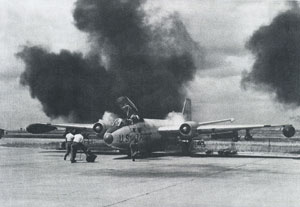 During the Vietnam War, members of the 13th flew both day and night missions that included close air support, interdiction, striking enemy troops concentrations, equipment and storage areas, roads and bridges and transportation routes and vehicles. They also flew reconnaissance, escort and high altitude sky-spot missions when weather prevented visual attacks. Targets in North Vietnam and Laos were hit as well as those in South Vietnam. During the Vietnam War, members of the 13th flew both day and night missions that included close air support, interdiction, striking enemy troops concentrations, equipment and storage areas, roads and bridges and transportation routes and vehicles. They also flew reconnaissance, escort and high altitude sky-spot missions when weather prevented visual attacks. Targets in North Vietnam and Laos were hit as well as those in South Vietnam.
On many night missions, C-130 flare ships would meet the B-57s in the target area to light up the target with two million candle power flares. On 9 May 1967, the B-57s started carrying their own flares in addition to their bomb loads.
After crews had flown their first night mission, they became eligible to wear the Doom Pussy patch which was created by 13th navigator, Bob Galbreath. The patch depicts a B-57 flying at night into the jaws of a large cat. The Vietnamese wording which translates to, “Into the Jaws of the Cat of Death,” was what the Vietnamese thought of flying night missions, especially in the mountains.
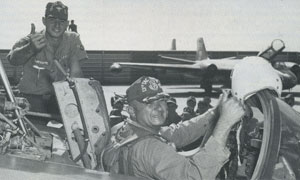 War correspondent Elaine Shepard wrote two books entitled, The Doom Pussy and Doom Pussy II, in which she related her first-hand experiences during the Vietnam War and especially her experiences with the 13th Bomb Squadron. War correspondent Elaine Shepard wrote two books entitled, The Doom Pussy and Doom Pussy II, in which she related her first-hand experiences during the Vietnam War and especially her experiences with the 13th Bomb Squadron.
On 9 October 1966 the 8th/13th base of combat operations moved from DaNang AB to Phan Rang Air Base. On 17 June 1967, the 13th observed its 50th Anniversary with an aircraft fly-by at Clark AB, Philippines, a squadron Open House, and a formal Dining-In ceremony. (The official date of the anniversary is 14 June, but the combat commitment in Vietnam prevented celebrating on the exact day).
On 15 January 1968, the squadron flew its 1,000th combat sortie of its final deployment and was then inactivated. All personnel, aircraft, and equipment were reassigned to the 8th Bombardment Squadron, Tactical, which was itself reassigned from the 405th Fighter Wing to the 35th Tactical Fighter Wing.
A little more than a year later, the 13th was brought out of retirement and assigned to the 15th Tactical Fighter Wing of the Tactical Air Command, at MacDill AFB, Florida. The wing’s mission was to provide replacement training for combat aircrews and maintenance personnel.
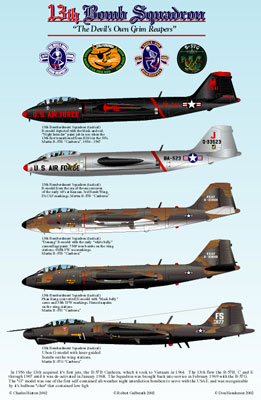 The 13th's new mission was related, but different, in that it was to become proficient in a new model of the Canberra -- the B-57G and to develop tactics, techniques and operations in the aircraft and its associated equipment. The “G” model was an electronic bomber with a highly sophisticated weapons system, including radar for precise navigation, a low-level television sensor and an infrared sensor for pinpointing targets, day or night, and a computer that provided bombing solutions. Major aircraft modifications included: removing the guns and reconfiguring the forward fuselage to accommodate the new equipment, installing more powerful engines, putting foam in all fuel tanks, installing zero-zero ejection seats, adding armor plating around the cockpit and other areas, and installing the moving target indicator, terrain following and avoidance radar . The B-57G was the first USAF aircraft to designate and drop laser guided bombs on a target. The 13th's new mission was related, but different, in that it was to become proficient in a new model of the Canberra -- the B-57G and to develop tactics, techniques and operations in the aircraft and its associated equipment. The “G” model was an electronic bomber with a highly sophisticated weapons system, including radar for precise navigation, a low-level television sensor and an infrared sensor for pinpointing targets, day or night, and a computer that provided bombing solutions. Major aircraft modifications included: removing the guns and reconfiguring the forward fuselage to accommodate the new equipment, installing more powerful engines, putting foam in all fuel tanks, installing zero-zero ejection seats, adding armor plating around the cockpit and other areas, and installing the moving target indicator, terrain following and avoidance radar . The B-57G was the first USAF aircraft to designate and drop laser guided bombs on a target.
The squadron was to train for deployment to Southeast Asia as a unit. Personnel of the squadron underwent training at MacDill AFB and at a number of other locations. The unit's first commander was assigned on 23 April 1969, two months after the squadron's activation. Since B-57G aircraft were not yet available, the 13th flew B-57Cs belonging to the 4424th Combat Crew Training Squadron of the 15th Wing, the unit that had conducted B-57G combat crew training.
Graduates of the 4424th Squadron B-57G course joined the 13th Squadron during the next six months. Upon arrival, personnel either began operational flying in the borrowed B-57Cs or completed other training. Flight crews attended special courses at the Westinghouse Technical Training Center in Baltimore, Maryland; Basic Survival School at Fairchild AFB, Washington; Water Survival School at Homestead AFB Florida; and Air-to-Ground Operations School at Eglin AFB, Florida. Maintenance personnel attended schools at Hill AFB, Utah, while life support personnel were trained at Kirtland AFB, New Mexico. A B-57G flight simulator arrived at MacDill AFB in December 1969, and training began immediately. By 31 December 1969, the squadron was nearly up to its authorized strength.
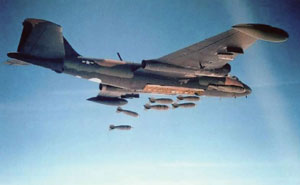 B-57G aircraft began arriving for the 13th Squadron on 26 May 1970, and the borrowed B- 57Cs were returned to the 4424th Squadron. All authorized aircraft were on hand by August 1970, and by that time the13th had received orders for movement to Ubon RTAFB,Thailand. Intensive training followed, with special emphasis on long-range cruise control missions to prepare the aircrews for their long flights to Thailand. B-57G aircraft began arriving for the 13th Squadron on 26 May 1970, and the borrowed B- 57Cs were returned to the 4424th Squadron. All authorized aircraft were on hand by August 1970, and by that time the13th had received orders for movement to Ubon RTAFB,Thailand. Intensive training followed, with special emphasis on long-range cruise control missions to prepare the aircrews for their long flights to Thailand.
Effective 15 September 1970, the 13th Squadron was transferred from Tactical Air Command to Pacific Air Forces, and simultaneously came under operational control of the 8th Tactical Fighter Wing at Ubon. The phased movement began on 14 September. B-57s flew to Southeast Asia by way of Alaska, the Aleutians, Midway, Wake, Guam, Okinawa, and the Philippines, under the nickname Coronet Condor.
By the end of September, squadron personnel and equipment arrived in C-141s and C-130s, and the squadron flew its first combat mission on 17 October 1970.
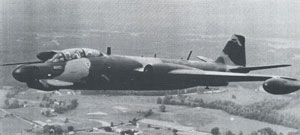 The new 13th mission was to perform night reconnaissance and strikes, primarily against enemy lines of communication. On 31 October 1970, the 13th was formally assigned to the 8th Tactical Fighter Wing. From 17 October 1970 to 10 April 1972, the 13th Bombardment Squadron, Tactical, utilized its specially equipped B-57s exclusively for night strikes. The crews and their planes were excellent in performing this mission and received a Presidential Unit Citation and an Air Force Outstanding Unit Award with Combat V for their combat performance. The new 13th mission was to perform night reconnaissance and strikes, primarily against enemy lines of communication. On 31 October 1970, the 13th was formally assigned to the 8th Tactical Fighter Wing. From 17 October 1970 to 10 April 1972, the 13th Bombardment Squadron, Tactical, utilized its specially equipped B-57s exclusively for night strikes. The crews and their planes were excellent in performing this mission and received a Presidential Unit Citation and an Air Force Outstanding Unit Award with Combat V for their combat performance.
In late November 1971, the 13th was alerted for redeployment, but one month later the orders changed and the squadron continued their operational mission. In February 1972, however, the squadron was again alerted for return to the United States from Ubon, but on 30 March 1972, North Vietnam launched a major assault into South Vietnam---and the war, which had been dwindling, became intense once more.
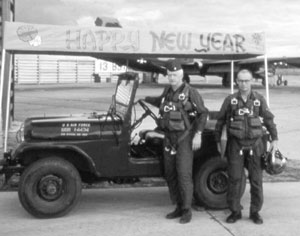 Nevertheless, by 12 April, most--if not all--of the personnel and equipment of the 13th had departed Ubon for Forbes AFB, Kansas and the squadron itself was reduced to paper status at Ubon. During its tour with the 8th Tactical Fighter Wing, the 13th destroyed 2,652 enemy supply vehicles and damaged 50 more. They also destroyed or damaged numerous boats, gun sites, and other targets. Nevertheless, by 12 April, most--if not all--of the personnel and equipment of the 13th had departed Ubon for Forbes AFB, Kansas and the squadron itself was reduced to paper status at Ubon. During its tour with the 8th Tactical Fighter Wing, the 13th destroyed 2,652 enemy supply vehicles and damaged 50 more. They also destroyed or damaged numerous boats, gun sites, and other targets.
In December 1972, the 13th Bombardment Squadron, Tactical, designation was transferred to Clark AB, Philippines, where it remained in an unmanned status; however, in July 1973, it was re-designated the 13th Fighter Squadron. Then on 30 September 1973, the 13th was simultaneously re-designated the 13th Bombardment Squadron, Tactical, and inactivated. |
Article taken from Invader Magazine July 2001
B-57/Vietnam War - The Unsung Canberras |
Article taken from Invader Magazine March 2005
B-57/Vietnam War - The Forgotten Years Part II |
Article taken from Invader Magazine March 2007
B-57G Redbirds at Ubon
|
|
| The Virtual Wall Vietnam Veterans Memorial |
|
| back to top |
|
 |
2000-2005
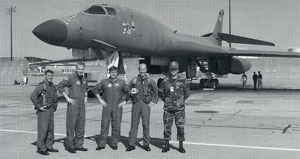 On June 14, 2000 after over 26 years in hibernation, the Grim Reapers returned to the active Air Force, eager to add to their lineage as the Air Force’s most storied Bomb Squadron. Initially the squadron was charged with producing missions for the B-1 Formal Training Unit and a small cadre of Grim Reapers that was to build up to full combat strength over several years. On June 14, 2000 after over 26 years in hibernation, the Grim Reapers returned to the active Air Force, eager to add to their lineage as the Air Force’s most storied Bomb Squadron. Initially the squadron was charged with producing missions for the B-1 Formal Training Unit and a small cadre of Grim Reapers that was to build up to full combat strength over several years.
On September 11, 2001 the United States was attacked by Islamic terrorists. In early 2002 the 7th Bomb Wing deployed the 13th Bomb Squadron with the 9th Expeditionary Bomb Squadron and performed admirably, most notably in Operation ANACONDA. Upon returning the Reapers were named the 7th Bomb Wing’s executive agent for support of the B-1 Test program which would go on to add many lethal capabilities to the aircraft including the incredible Block E upgrade which made the B-1 “the platform of choice” in the nation’s war on terror. Additionally, the Reapers became responsible for supporting the B-1 Weapons Instructor Course, the program charged with training and graduating at the PhD level the most dominant and in demand aviators in the Air Force. This natural relationship put the 13th in the enviable position of being the first in the operational bomber community to train on the latest upgrades, and often training with the Air Force’s premier instructors.
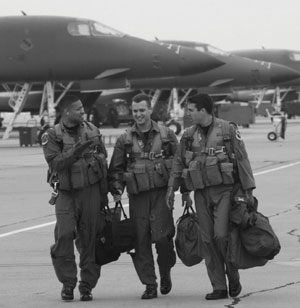 In early 2003 most Reapers again deployed during Operation Iraqi Freedom to Andersen AFB, Guam on a mission to keep North Korea in check. The North was in no mood to break the Armistice, having seen the Reapers in action before. Upon returning from Guam, the 7th Bomb Wing Commander charged Lt Col Pete Holcomb, the 13th Bomb Squadron DO, with devising and running the first ever Iron Thunder surge. His audacious plan called for scheduling 120 missions over three days. Many observers laughed at the thought of executing even 75 sorties –, or 108 sorties. The crews began on Oct. 7, flying sorties around the clock until late in the night Oct. 9. In a tremendous effort, the 7th Bomb Wing crews pushed their B-1 Lancers to a record-breaking 114 flights in 68 hours resulting in 321 simulated bombing runs on targets. Col. Jeffrey Beene, 7th Operations Group commander said "Nothing like this has ever been done in the B-1 and it is quite possible that nothing like this has been done in the history of bomber aviation." Col. Jonathan George, 7th BW commander remarked "we've known for a long time that B-1s could strike targets from long distances," and "we've also recently demonstrated the ability for them to stay in the air for long periods of time … waiting for targets to arise. But this is the first time I know of where we've demonstrated the impressive amount of firepower in such a short period of time that we could potentially unleash on the enemy if needed." In early 2003 most Reapers again deployed during Operation Iraqi Freedom to Andersen AFB, Guam on a mission to keep North Korea in check. The North was in no mood to break the Armistice, having seen the Reapers in action before. Upon returning from Guam, the 7th Bomb Wing Commander charged Lt Col Pete Holcomb, the 13th Bomb Squadron DO, with devising and running the first ever Iron Thunder surge. His audacious plan called for scheduling 120 missions over three days. Many observers laughed at the thought of executing even 75 sorties –, or 108 sorties. The crews began on Oct. 7, flying sorties around the clock until late in the night Oct. 9. In a tremendous effort, the 7th Bomb Wing crews pushed their B-1 Lancers to a record-breaking 114 flights in 68 hours resulting in 321 simulated bombing runs on targets. Col. Jeffrey Beene, 7th Operations Group commander said "Nothing like this has ever been done in the B-1 and it is quite possible that nothing like this has been done in the history of bomber aviation." Col. Jonathan George, 7th BW commander remarked "we've known for a long time that B-1s could strike targets from long distances," and "we've also recently demonstrated the ability for them to stay in the air for long periods of time … waiting for targets to arise. But this is the first time I know of where we've demonstrated the impressive amount of firepower in such a short period of time that we could potentially unleash on the enemy if needed."
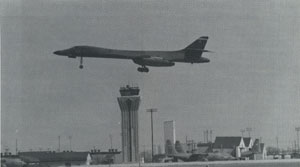 Starting in the fall of 2003, the B-1 fleet initiated a transformation with major computer and software upgrades, and the Reapers were at the forefront. The 13 BS was the first operational unit assigned to fly Block E B-1s. This revolutionary aircraft provides a mixed load of GPS-guided and unguided weapons which increases the combatant commander’s options and flexibility. Including a new air-to-air radar capability, the Block E B-1 was a monumental leap forward in providing American forces long-range, persistent and precise airpower. As the initial cadre, the Reapers were responsible for training the core of the 7 BW. The Reapers kicked off 2004 by flying none other than the USAF Chief of Staff. Gen John Jumper was treated to a flight in one of the first B-1s converted to Block E, practicing time-sensitive targeting and global messaging. After the sortie he became an honorary Reaper in the presence of Oscar and the Reaper Mayor. Starting in the fall of 2003, the B-1 fleet initiated a transformation with major computer and software upgrades, and the Reapers were at the forefront. The 13 BS was the first operational unit assigned to fly Block E B-1s. This revolutionary aircraft provides a mixed load of GPS-guided and unguided weapons which increases the combatant commander’s options and flexibility. Including a new air-to-air radar capability, the Block E B-1 was a monumental leap forward in providing American forces long-range, persistent and precise airpower. As the initial cadre, the Reapers were responsible for training the core of the 7 BW. The Reapers kicked off 2004 by flying none other than the USAF Chief of Staff. Gen John Jumper was treated to a flight in one of the first B-1s converted to Block E, practicing time-sensitive targeting and global messaging. After the sortie he became an honorary Reaper in the presence of Oscar and the Reaper Mayor.
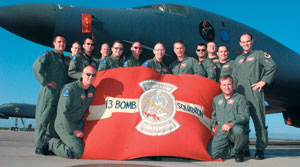 Shortly thereafter the nation called, and again many Reapers went to battle, this time from the tiny island of Diego Garcia in the Indian Ocean. Upon returning from combat, the Reapers were tasked by the Operations Group Commander with qualifying the 7 BW force in the Block E B-1 in order to deploy once again in a short five months. Again, under the direction of the 7 BW/CC, Maj Greaney, the 13 BS/DO, was tasked to lead Iron Thunder 04-4 with the goal of delivering massive concentrated firepower in the form of live and inert weapons. Maj Greaney carefully integrated limited range space, jet availability, and realistic threat and target scenarios. His planning and leadership resulted in 77 effective sorties in less than 68 hours. More astounding was the fact that forty-seven of the sorties released a record 383 training weapons. Exercising in real world operational environments, formations were able to exercise close air support taskings and time sensitive targeting with Joint Tactical Air Control units deployed on ranges. The record release of over 218 tons of ordnance demonstrated the B-1’s ability to perform a high operations and maintenance surge and was a perfect dress rehearsal for the first ever Block E B-1 deployment three months later. In December of 2004, for the fourth time in under four years, Dyess B-1s answered the call to war. This time every single Reaper crewmember and most enlisted support staff deployed to Diego Garcia as Shortly thereafter the nation called, and again many Reapers went to battle, this time from the tiny island of Diego Garcia in the Indian Ocean. Upon returning from combat, the Reapers were tasked by the Operations Group Commander with qualifying the 7 BW force in the Block E B-1 in order to deploy once again in a short five months. Again, under the direction of the 7 BW/CC, Maj Greaney, the 13 BS/DO, was tasked to lead Iron Thunder 04-4 with the goal of delivering massive concentrated firepower in the form of live and inert weapons. Maj Greaney carefully integrated limited range space, jet availability, and realistic threat and target scenarios. His planning and leadership resulted in 77 effective sorties in less than 68 hours. More astounding was the fact that forty-seven of the sorties released a record 383 training weapons. Exercising in real world operational environments, formations were able to exercise close air support taskings and time sensitive targeting with Joint Tactical Air Control units deployed on ranges. The record release of over 218 tons of ordnance demonstrated the B-1’s ability to perform a high operations and maintenance surge and was a perfect dress rehearsal for the first ever Block E B-1 deployment three months later. In December of 2004, for the fourth time in under four years, Dyess B-1s answered the call to war. This time every single Reaper crewmember and most enlisted support staff deployed to Diego Garcia as 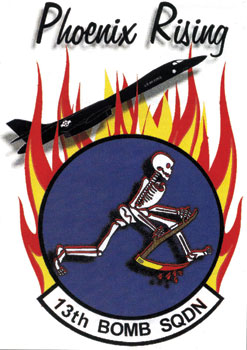 members of the 40th Air Expeditionary Group. All members returned standing tall as the final Grim Reapers to deploy in the B-1. members of the 40th Air Expeditionary Group. All members returned standing tall as the final Grim Reapers to deploy in the B-1.
One legacy the 13th Bomb Squadron at Dyess was happy to embrace was the renowned Reaper Pride. In February 2004, on Friday the 13th the Reapers held a special celebration. While Reaper decorations covered the base, they watched their maintenance team compete in a bomb loading competition at 1113, conducted a high speed fly-by at 1213, delivered the wing commander to a meeting in the new Reaper-mobile at 1313, took a squadron photo at 1413, toasted Reapers of the past and present at 1513, performed the retreat ceremony at the base flagpole then shared a Reaper cake with everyone present at the Heritage Club at 1713, and gathered with families for dinner and entertainment at 1813. On Friday the 13th of August they held a similar celebration to include cleaning and refurbishing the Dyess airpark B-26 Chadwick. In the fall of 2004, the Reapers supported the repatriation ceremony for Lt Colonel Randolph A. Perry’s remains. Lt Colonel Perry perished when he was shot down in a B-52 during Operation LINEBACKER II against Hanoi, North Vietnam on 20 Dec 1972. The ceremony in Troy, Montana was attended by members of Lt Colonel Perry’s immediate family, the local community, the Malmstrom Air Force Base Honor Guard and included keynote remarks by Montana Governor Judy Martz. The Reapers were honored to participate in the ceremony for Lt Colonel Perry, whose remains are finally at rest on U.S. soil after 32 years away from home.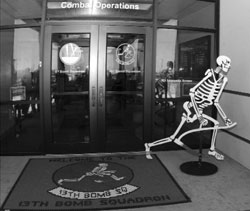
The men and women of the Dyess 13th Bomb Squadron have maintained a tradition of extraordinary accomplishments just as Reapers have done since 1917. The Dyess Reapers have been outstanding stewards of the proud and distinguished heritage of the 13th BS. They have made remarkable leaps in transforming the B-1 as a combat airframe and have added to the 13th Bomb Squadron’s enduring legacy and gratefully pass on the flag to future Reapers who will continue to uphold its fine traditions. Once a Reaper, always a Reaper! |
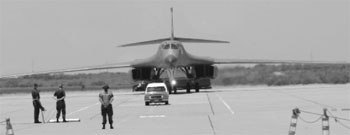 |
Article taken from Invader Magazine July 2002
B-1B 1st Triple Munitions Drop |
Article taken from Invader Magazine July 2003
B-1 Commander's Report Return From Guam |
Article taken from Invader Magazine November 2005
B-1 In Afghanistan |
| back to top |
|
|
| 2005-2013 |
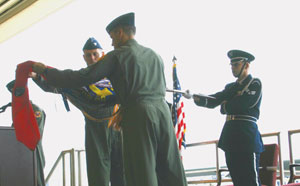 In June 2005, the United States Air Force announced that the 13th Bomb Squadron would replace the 325th Bomb Squadron at Whiteman AFB Missouri and fly a new bomber, the B-2 Spirit. On 23 September 2005 the squadron flags were passed in the time honored tradition and once again Oscar would be riding into combat in the nation's newest bomber. In June 2005, the United States Air Force announced that the 13th Bomb Squadron would replace the 325th Bomb Squadron at Whiteman AFB Missouri and fly a new bomber, the B-2 Spirit. On 23 September 2005 the squadron flags were passed in the time honored tradition and once again Oscar would be riding into combat in the nation's newest bomber.
The B-2 represented a quantum leap forward in new design in aerospace. This design was to penetrate the most sophisticated, foreseeable defenses. have long range and large payload capability, be mission flexible and be ready and available. This became the Stealth bomber which cost 1.4 billion dollars and was expected to be in service for 50 years. Twenty one of these jets were built and the first was delivered in 1995.
The B-2 has the capability to hit 80 targets with precision guidance. Since combat missions can last 40 hours, the highly qualified crews have rigorous training programs to complete and long hours in the simulator to help them adjust to extended missions. They are dual qualified in T-38 aircraft and fly short missions to help them maintain their flying skills in between B-2 flights.
Deployments are frequent at Whiteman. When sent to the Pacific to Guam, the B-2 provides the Pacific Air Force Commander with significant capability to deter and dissuade any potential aggressor in the region and to be able to act fast and be far reaching in 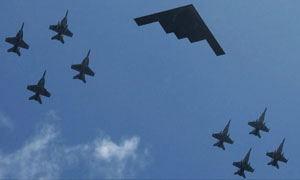 range. Combat training missions integrate fighters, bombers and navy carrier groups in joint actions as well as participating with coalition and allied forces in combined exercises. range. Combat training missions integrate fighters, bombers and navy carrier groups in joint actions as well as participating with coalition and allied forces in combined exercises.
In June 2006 the 13th deployed to Andersen Air Force Base, Guam for their first Pacific training. During that period they became the first B-2's to deploy to Australia and fly training sorties on Australia's Delamere Air Weapons Range. At RAAF Darwin they were the first B-2 to land on Australian soil and then to perform an Engine Running Crew Change.
Four B-2s and 170 Airmen from the 13th Bomb Squadron and 509th Bomb Wing participated in RED FLAG 07.2-1 from 12-26 January and RED FLAG 07.2-2 from 2-17 February 2007 at Nellis AFB, NV. This was the second time the 13th Bomb Squadron deployed to RED FLAG as a unit. They joined 5,200 other military members and more than 200 aircraft from the United States, United Kingdom and Australia who took part in the training.
As in previous RED FLAG exercises, this one was designed to increase combat readiness, capability and 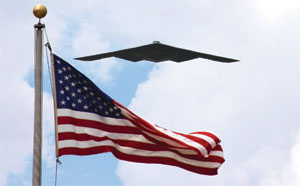 survivability of participating units by providing realistic training in a combined air ground and electronic threat environment. The 2007 exercise, was dubbed “Colonial Flag,” because both the United States and Australia were once colonies of the United Kingdom. This marked the 32nd year for RED FLAG operations. survivability of participating units by providing realistic training in a combined air ground and electronic threat environment. The 2007 exercise, was dubbed “Colonial Flag,” because both the United States and Australia were once colonies of the United Kingdom. This marked the 32nd year for RED FLAG operations.
Other strike aircraft participating in the exercise included the B-1 Lancer, Royal Air Force GR-4 Tornado, F-15E Strike Eagle, the F-111 Aardvark and the F-117 Nighthawk. The AH-64 Apache Army helicopter, flown by the Utah National Guard, returned after several years of absence from RED FLAG. The Nevada Test and Training Range, the location for the exercise, can accommodate many aircraft at one time, allowing for a realistic training experience for the more than 200 aircraft that participated.
A milestone in stealth airpower was achieved during the second portion of the exercise when, for the first time, the B-2 flew coordinated missions with the Air Force’s newest stealth asset, the F-22 Raptor. The role of a squadron of F-22 aircraft from the 1st Fighter Wing, Langley AFB, VA, was primarily to act as air-to-air fighter escort for air-to-ground strike aircraft, and to demonstrate its air-to-ground capabilities.
This exercise was an opportunity for the Air Force to test the global strike task force (GSTF) concept. GSTF is a rapid-reaction force of B-2 and F-22s that opens the way for other combat forces. The task force leads with F-22 stealth fighters to clear a path, taking out enemy aircraft and advanced anti-aircraft missile launchers. B-2 stealth bombers follow to destroy assets that threaten U.S. deployments such as Scud missile launchers, chemical-weapon bunkers and air and shore defenses. The Global Strike Task Force concept has morphed into preparation of the individual aircrew, but also trains the fighting force as a whole.
Tragedy struck the 13th on February 23, 2008 when the B-2 Spirit of Kansas, while returning to Whiteman at the end of the Pacific deployment, crashed on takeoff from Andersen AFB, Guam. All B-2 aircraft were grounded for two months during the accident investigation board proceedings. The board determined that moisture penetrated aircraft sensors and caused the jet to pitch up and roll and yaw to the left before plunging to the ground.
Both pilots ejected safely, just after the left wing hit the ground. This was the first B-2 aircraft loss after nearly 20 years of flying.
After the B-2 crash at Anderson AFB, Guam in 2008, the 13th conducted a number of inspections and exercises and activities to maintain its global readiness during 2009-2011. In the meantime in North Africa, Libyan president Kaddafi was conducting war against his own citizens using air strikes and heavy artillery to defeat them. The United Nations declared a No Fly Zone in Libya to try and protect the country from its leader. When this action didn’t stop the attacks, Operation Odyssey Dawn was implemented.
On March 22, 2011, which was day four of the operation, four Reaper B-2s began a 30+ hour, four refueling mission from Whiteman AFB to help neutralize the Libyan Air Force. The 13th lead the attack which included planes from their sister B-2 squadron the 393rd, the 131st Bomb Wing and US Naval forces totaling 20 aircraft. The results were 45 of 48 targets destroyed and the Libyan Air Force put out of action. Superior mission performance was not just taking place in the cockpits of the aircraft. While Odyssey Dawn aircrew members Squadron Commander Lt Col Mark Pye with Major Richard Ganske, Lt Col Mark Seng with Major Luke Jayne, Major Jon Avery with Major Scott Weyermuller and Lt Col Michael Pyburn with Col Keith Butler were able to complete their mission with near perfection, other squadron Reapers worked hard to provide the mission support that made it successful. Among those individuals were the mission leads and pilot planners: Majors Justin Grieve, William Hepler, Peter Maturo and Scott Wuenstal and Captains Shaun Germain, Luke Lucero, Christopher Diller and Michael Klotz. Those individuals and many others made this mission a total squadron success.
March 2011 proved to be a busy time for the 13th. In addition to Odessey Dawn, they simultaneously participated in an exercise assisting the 393rd BS by sending a number of pilots and crews to the annual Red Flag at Nellis AFB, Nevada.
The following year the 13th would again join others at Red Flag which turned out to be the largest one flown to date. This exercise lasted over three weeks, involved more than 50 units (21 of which were airborne units) and included our Royal Air Force and Royal Australian Air Force allies.
Without missing a beat the Reapers participated in another Red Flag exercise at Eielson AFB, Alaska in April. Smooth transitioning from one major exercise to another was credited to the efforts of Major Timothy Sutton and Capt Marcus Antonini.
In June 2012 the Squadron turned over leadership from Lt Col Mark Pye to Lt Col Jeffrey Schreiner. No stranger to B-2 operations, Lt Col Schreiner had been a member of the 393th BS before he became Chief of Safety for the 509th Bomb Wing where he managed flight, ground and weapons safety to included nuclear surety for the B-2. His awards include the Meritorious Service and Air Force Achievement Medals and Distinguished Graduate at Squadron Officers’ School.
Just one month after Lt Col Schreiner’s arrival, the squadron was asked to participate in the Royal International Air Tattoo Air Show in England before a crowd of one hundred and sixty-three thousand spectators. This was a special occasion for the 13th to demonstrate its capabilities in combination with other forces to achieve a common goal. British exchange pilot Flight Lt Adam Curd ended his American tour at Whiteman by piloting a B-2 back home for the show.
The Reapers started 2013 by preparing for a Guam and Diego Garcia deployment. This was the first time the unit would operate from two forward locations at once and required the full support of all personnel for over one month.
On 22 March 2013 the Squadron was again called upon to support our nation. This mission was to assist in lowering the tensions in the North Korean Peninsula being created by the threats of North Korean government. Operation Foal Eagle was set in motion as a demonstration of ability, not force. On March 22nd two B-2s from Whiteman, crewed by Reaper Captains Justin Meyers and Andrew Kousgaard, and Captain Joshua Wiitala with Maj Brian Stiles of the 393rd. The mission lasted over 30 hours and required multiple air refuelings. The two Spirits were accompanied by F-22s and F-16s on the mission to deter further aggressive actions by hostile forces.
After Operation Foal Eagle Captain Wiitala said, ”It was an honor to be able to take part in the B-2’s deterrence mission in such a tangible and visible way”
2013 marks the 20th Anniversary of the B-2s at Whiteman AFB.
|
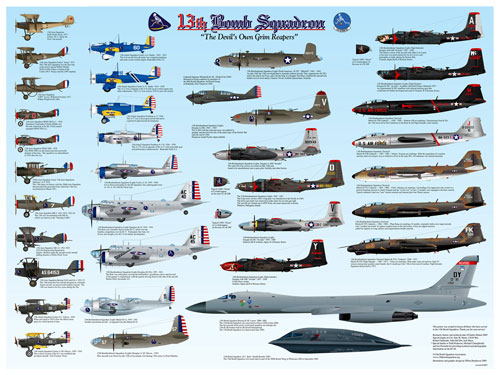 |
Article taken from Invader Magazine November 2005
The New Whiteman |
Article taken from Invader Magazine July 2006
Report from Whiteman |
Article taken from Invader Magazine November 2006
B-2's Complete Successful Deployment |
| back to top |
| April 2013 - March 2015 |
April 2013 saw the execution of Exercise CONSTANT
VIGILANCE, where the squadron flew off 6 of the 12 nuclear
generated B-2s. The unit survived many inspections to include the
Air Force Global Strike Command (AFGSC) Consolidated Unit
Inspection where the squadron was honored with the most "Superior
Performers" in the Operations Group. The Reapers continued their
flawless execution of strategic deterrence by generating 12 B-2
bombers in Exercise GLOBAL THUNDER and executed flawlessly in the
SECDEF visibility Exercise NEPTUNE FALCON in December 2013.
Through all the tremendous accomplishments of the Reapers in 2013,
the squadron was nominated by Major Command (MAJCOM) AFGSC for the
USAF Citation of Honor Award for outstanding contribution of an
organization to the development of aerospace power for the
betterment of mankind.
The Reapers survived the Nuclear Surety Inspection (NSI) of
January 2014 and led the 509th Bomb Wing in Exercise RED
FLAG-NELLIS once again demonstrating the uncanny capabilities of
the B-2 Stealth Bomber Fleet. Nuclear deterrence was assured again
in Exercise CONSTANT VIGILANCE in April 2014. On June 13, 2014 at
1300 hours, Lt. Col. Jeffrey "Opie" Schreiner relinquished command of
the Deadly Reapers to current REAPER 1 Lt .Col. Robert "STAB" Makros
(see below). The 13th Bomb Squadron was honored to have a
number of Reapers from the Association in attendance. In August
2014, the Reapers augmented sister combat squadron, 393rd Bomb
Squadron Tigers, in the USPACOM directed deployment at forward
operating location (FOL) Andersen AFB, Guam. In October 2014, the
Reapers again were on the leading edge of nuclear deterrence
generating 12 nuclear laden aircraft and once again supported
Exercise RED FLAG-NELLIS in January-February 2015.
The ops outlook is a busy one for the Spring/Summer 2015. In May
2015, we are cut to participate in Exercises NEPTUNE FALCON,
CONSTANT VIGILIANCE and COMBAT HAMMER in a three week time span.
We will keep you posted on further ops tempo announcements and
look forward to connecting with the 13 BS Reaper Association in
Branson later this year!
REAPER PRIDE! |
| back to top |
|
| 2016-2017 |
During the summer of 2016, Lt. Col Matthew "Shin" Newell took command of the 13th Bomb Squadron.
On 18 January 2017, two B-2s flew combat sorties over ISIS training camps in Sirte, Libya killing 78 militants. This mission would come to be known as Operation ODYSSEY LIGHTNING. The B-2s together dropped a total of 116,000 pounds of Joint Direct Attack Munitions (JDAMs). These attacks were followed by an MQ-9 Reaper remotely piloted aircraft (RPA) firing Hellfire missiles. In the lead aircraft were two Reapers. Each aircraft flew a 34 hour round trip mission from Whitman Air Force Base with a total of five air refuelings en route.
2017 was a great summer for the Reapers. The 100th anniversary was a huge success with three great events. To start the celebration off, the Reapers hosted a red shirt/party suit night at the O Club. The next day included a tour of the B-2 and simulators followed by a formal banquet honored by several distinguished guests, including General Robin Rand, Commander of the Air Force Global Strike Command. The next day this special celebration was concluded with a golf tournament and BBQ cookout.
Toward the end of the summer the Reapers completed another Nuclear Surety inspection (NSI) with some of the best results seen in years with Zero discrepancies.
|
| back to top |
|
| 2018 |
The 13th Bomb Squadron completed 135 cross country flights during 2018 in support of official missions, and Lt Col Geoffrey "Fletch" Steeves became its new commander. In September Lt Col Steeves and Major Nicolas "Wolf" Anderson made a trip to the Air Force Academy to brief cadets about the platform, mission and training requirements of the B-2 Stealth bomber. (Pictured below are Fletch and Wolf talking to Cadets).
Honoring major American sports events is a tradition for which the Grim Reapers are well known, and that tradition continued in 2018. While performing a practice flyover prior to the start of a Pittsburgh Steelers-Kansas City Chiefs football game, the crews were unaware, as they executed a four ship formation pass, that the colors were being brought on to the field of a local high school football game about to start. Several Gold Star family members were in attendance at that game, and a heartfelt letter of thanks was received from one family whose deceased military members were being honored that day.
Then, after the Steelers/Chiefs flyover, the Reapers were invited to attend the remainder of the game and help celebrate as seen in the picture below. Additional flyovers were also conducted at Ohio State University, University of Nebraska and Kansas University.
2019 will be another very busy year as the 13th will receive several new pilots for Initial Qualification Training, who upon completion will then become "The Best Bomber Pilots in the World".
(Info and photos provided by Antony J. Roop, 13th Bomb Squadron Historian).
|
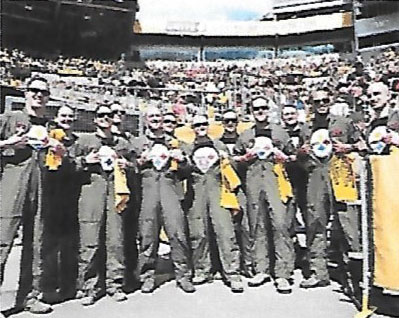
|
| At Pitt-Steelers vs KC Chiefs Game: (l to r) Lt Mabee, Capt J. Crum, Capt Kolod, LtCol Steeves, Maj Brolin, Capt Stock, Capt B. Crum, Capt Cooper, Capt Tradup, Capt Harden, Lt Cameron, and Capt Hudanich |
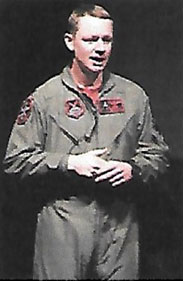 |
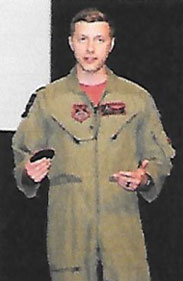 |
| LtCol Geoffrey "Fletch" Steeves |
Maj Nicholas "Wolf" Anderson |
|
| back to top |
|
| 2019 - 2020 |
| These have been two variable and still busy years for the 13th Bomb Squadron at Whiteman AFB, Missouri. The year 2019 started off rather normally. In June a transition of command occurred when Lt Col Michal P. "Ox" Polidor took command. The Reapers completed 103 cross country flights and 3457 sorties for 3810 hours to maintain continuous training, and to support official functions. Quarterly exercises were initiated with Joint Terminal Attack Controllers (JTAC) Talon Fury, to improve their mission capabilities. These consisted of week-long training periods of approximately 32 sorties. They helped pass coordinates for various targets to improve B-2 proficiencies and introduce basic skills needed in the Combat Air Force (CAF). Such training events will continue for the foreseeable future.
One of the unit's favorite past times has been representing the Air Force during flyovers. These outreach events serve as excellent recruitment tools and show support for our local community and nationwide partnerships. The Reapers flew over many outstanding events this season, including Pittsburgh Steeler and Nebraska Cornhusker football games. Lt Col Nichola "Rogue" Polidor was the first female to fly a B-2 Stealth over the 2020 Rose Bowl. Another first for that event was having the first Latina female president for the Tournament of Roses Parade.
In November 2019, the Reapers teamed with the Whiteman Base Community Council sister city (California, Missouri) to support the Missouri Girls Town (MGT) for Christmas. MGT is a place where abandoned and troubled girls can be helped by providing them with a positive future. The unit donated a plethora of gifts which culminated in each girl receiving several that were on their wish lists. Volunteers for the Reapers wrapped gifts and completed a community service project of putting new bed frames and beds together for all the residents of MGT.
2020 started out normally, but then in March transitioned into observing COVID19 protocols due to the pandemic. All personnel were directed to telework to avoid exposure to the virus. To continue the 13th mission, a schedule was developed to make sure the education classes and flying training hours were completed to train, upgrade and recertify the world class B-2 bomber pilots. During the pandemic, Reapers completed 38 cross country flights, 3043 sorties and 3325.7 flying hours. The schedule was variable and included teleworking from home when flying or academics were not being performed. However, by July the squadron transitioned back to the semi-regular hours.
Once again, the 13th stepped up to assist the Missouri Girls Town by donating a set of Corn-Hole Boards to auction off for a fundraiser, and by virtually donating Christmas gifts via the internet due to the pandemic.
The year 2021 will be another very busy time as several new pilots will begin Initial Qualification Training which will lead to their becoming "The Best Bomber Pilots in the World"!
REAPER PRIDE!
Article by: Anthony J. Roop, 13th Bomb Squadron Historian
|
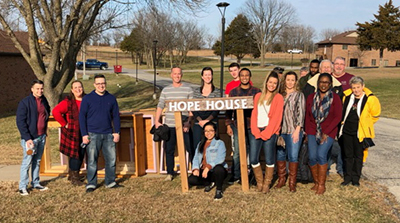 |
| (left to right): Capt Jordan Tencati, Stephanie Vollmer (MGT Director of Development), A1C James Madsen, Lt Col Michal "Ox" Polidor, Lt Col Nichola "Rogue" Polidor, A1C Elisa Jent, A1C Joshua Chesler, SSgt Jonathon Barrow, SrA Mackenzie Zipfel, MSgt (Ret) Amy Pringle, SrA Chardarius Alex, Civ Angel Arnold, Mr. Tony Roop, Mr. Joe Scallorns and Mrs. Fran Scallorns. |
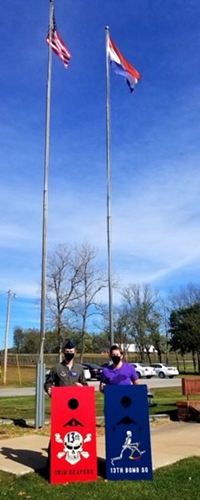 |
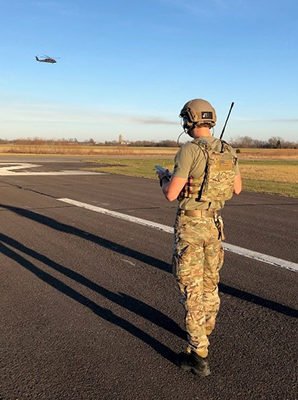 |
| (left to right): Capt Joshua Bradley, 13th Bomb Squadron, and Missouri Girls Town Executive Director, Jenny Preiss |
JTAC from Ft Hood, Texas working a UH-60 pickup for exercise Talon Fury 21.1 |
|
|
Biography of the 13th Squadron Commander
Lieutenant
Colonel Robert W. Sturgill Jr. |
| back to top |
|
|
